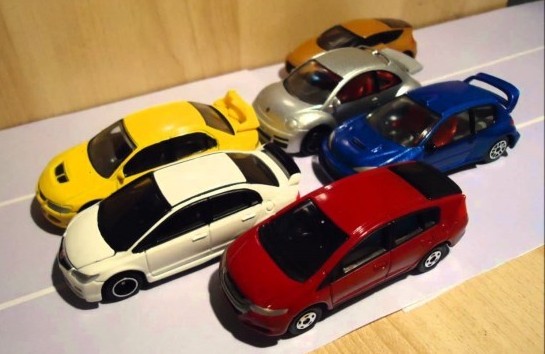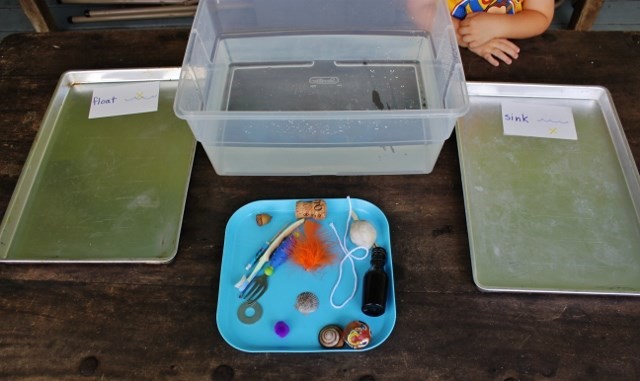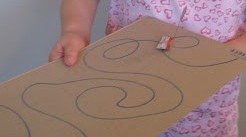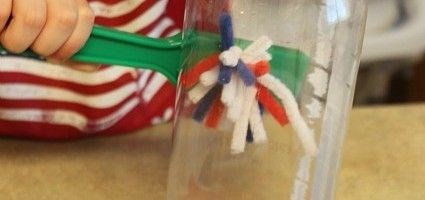Children are naturally interested in exploring their environment and finding out how things work. Their innate curiosity provides an opportunity to promote scientific discovery and inquiry (i). Young children enjoy finding answers to questions that interest them. “What will happen if…?” and “Why does…?” Preschoolers have the ability to observe, describe, compare, question, predict, experiment and reflect (ii).
Physical science is the study of how things move, the structure and properties of matter and how nonliving things change forms (i.e., ice to water). Children can “immediately observe the results of their actions” as they engage with objects and materials (iii). Adults can help children think deeper by asking thoughtful questions and providing guidance. In this fact sheet, we focus on the topics of matter, forces and motion, and magnets.

Matter
Matter is any physical substance that occupies space and has mass. It has observable properties, such as color, size, shape and weight. Matter exists in three different states: solids, liquids and gases. Matter can change from one state to another. For example, solids can become liquids, and liquids can become gases.
Ideas to Try
Solid, Liquid and Gases - Children can observe how matter changes from one state to another. Give children a small ice cube to hold in their hands over a container. As they rub their hands together, the heat from their hands will cause the solid ice to melt and become the liquid water. Later, heat some water and show preschoolers how water (liquid) can turn into steam (gas).
Sorting - Give young children opportunities to sort objects by color, size, shape or other physical characteristics, such as items that are hard and items that are soft. Think of unique ways to categorize objects, such as type of material (i.e., plastic, wood or metal), texture (i.e., rough or smooth) or type of transportation (i.e., land, sky or water). When selecting materials for young children, remember to avoid any small items that could pose a choking hazard.
Butter Making - Butter making demonstrates how a liquid can become a solid. Pour warm heavy cream into a small jar (about one-third full) with a lid. Make sure the lid is screwed on tightly, and shake the jar for about 10 minutes or until butter is formed. Add some salt to taste (optional). For a fun twist, create flavored butter by adding any of the following: herbs (chives, rosemary, cinnamon or oregano), lemon or lime juice, honey, or vanilla extract.
Bubble Blower - Bubbles are formed by blowing air into a liquid. When bubbles expand too much or touch a surface, they pop. Share a book about bubbles, such as Gilberto and the Wind by Marie Hall Ets. Create a bubble blower using a plastic cup. Poke a hole on the side of the cup (about 1 inch from the bottom of the cup) that is the same size as a plastic straw. Pour equal portions of water and dish soap into the bottom of the cup (below the hole). Push the straw into the hole in the cup, tilt the straw into the liquid, and start blowing lots of bubbles.
Forces in Motion
One type of physical science is the study of forces and motion. Forces could include gravity, magnetism, friction, buoyancy and momentum. For example, children can explore how things move or investigate how objects react when placed in water. Preschoolers benefit from having a variety of tools and materials to use as they experiment.
Ideas to Try
How Toys Work - Explore how toy cars work. Share with preschoolers that toy cars need a source of energy or some type of force to move. Ask children, “How do toy cars move?” and allow them to share their ideas. Some toy cars are powered by springs, gears or batteries, and other cars move as people are the source of energy and push or pull the toy cars. Give children time to explore different types of toy cars such as wind-up cars or cars with gears (friction- powered cars). Children can explore which cars go farthest or fastest. Discuss “why” and continue to observe, experiment and discuss.


Sink or Float - Children can explore buoyancy or what happens when items are placed in water by discovering which objects sink and which objects float. Provide preschoolers with a container of water and a variety of objects. Let the children predict whether each item will sink or float before they place the object in the water. Discuss whether the prediction was correct. Encourage children to think about what is similar and what is different about the objects that sink and float. Promote children’s language and literacy development during the exploration by using vocabulary words such as sink, float, heavy, light, bottom and top. Create a chart listing items that sink and items that float.
Ramp and Tunnel Building - Create ramps and tunnels by using pool noodles (cut lengthwise), gutters, PVC pipe or empty carpet rolls. Roll marbles or cars down the ramps.
Magnets
Magnets are a tool that can help children learn about magnetic forces. Magnets are only attracted to certain types of metals, such as iron, nickel and cobalt. Magnets have a magnetic north pole and south pole. If the same poles are placed near each other, they repel (push away). If different poles are placed near each other, they attract (pull together).
Ideas to Try
Attract or Not Attract - Provide children with magnets or magnet wands and items that will be attracted to a magnet and items that will not be attracted to a magnet. Give preschoolers the opportunity to predict whether an item will be attracted by the magnet and why. It can be fun to use items that are metal, but are not magnetic (i.e., silver or aluminum) to promote deeper thinking. Test the predictions. As the children explore the items with the magnets, they can sort them into two groups, “attract” and “not attract.” Discuss which items were attracted to the magnet (certain metals) and which items were not attracted to the magnet. Record your findings on a chart or graph.
Magnet Maze - Create a simple maze on a piece of paper. Place a magnetic color chip on the maze. Using a magnetic wand under the paper, have the preschoolers move the magnetic chip through the maze.


Magnetic Sensory Bottles - Place a variety of items that are magnetic in an empty water bottle. Items could include large paper clips, pipe cleaners (3-inch pieces), bells, springs and gears, and large screws. You could also add nonmagnetic items, such as aluminum foil or straws. Seal the bottle so children cannot open the bottle. Give children a magnet wand and have them explore what happens as they move a magnet wand near the different items. Children can guess which things are magnetic and which ones are not. Children are often surprised to discover aluminum foil is not magnetic, and pipe cleaners are magnetic.
Frozen Attraction - Freeze magnetic objects in ice and see if the objects are still attracted to magnets, even though they are inside the ice.
Fun Books to Share
- Adrienne Mason, Move It!: Motion, Forces and You.
- Amy Hansen, Floating and Sinking.
- Ashley Spires, The Most Magnificent Things.
- Pamela Anderson, Who Sank the Boat?
- Mary Hall Ets, Gilberto and the Wind.
Conclusion
Children are interested in the world and how it works. Preschoolers have a sense of wonder and desire to observe and predict. They benefit from opportunities to explore, manipulate, investigate and discover. Value young children’s questions, and take time to find out the answers together. Give children time, space and materials to explore on their own. Encourage preschoolers to record their observations by writing, drawing or taking photos. Appreciate the perspective of young children and the wonder they see in the world. Support children’s play and exploration as they actively engage in scientific inquiry (iv).
References & Additional Resources
- Kermani, H., & Aldemir, J. (2015). Preparing children for success: Integrating science, math and technology in early childhood classrooms. Early Child Development and Care,185(9),1504- 1527.
- Piasta, S. B., Pelatti, C. Y., & Miller, H. L. (2014). Mathematics and science learning opportunities in preschool classrooms. Early Education and Development, 25(4), 445-468.
- Gropen, J., Kook, J. F., Hoisington, C., & Clark-Chiarelli, N. (2017). Foundations of science literacy: Efficacy of a preschool professional development program in science on classroom instruction, teachers’ pedagogical content knowledge, and children’s observations and predictions. Early Education and Development, 28(5), 607-631.
- Inan, H. Z. (2015). 3Hs Education: Examining hands-on, heads-on and hearts-on early childhood science education. International Journal of Science Education, 37 (12), 1974-1991.
- Englehart, D., Mitchell, D., Albers-Biddle, J., Jennings-Towle, K., & Forestieri, M. (2016). STEM Play: Integrating Inquiry into Learning Centers. Lewisville, NC: Gryphon House.
Prepared By
Teresa Byington, Early Childhood Development Specialist
YaeBin Kim, Parenting Education and Family Literacy Specialist
Dan Weigel, Child and Family Specialist


